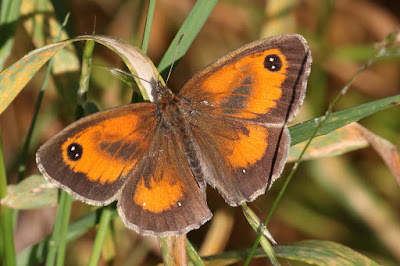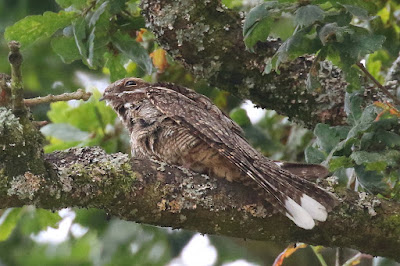It's that time of year when our part of the world in Purbeck fills up with visitors heading for the sandy beaches of Studland. Sometimes there's only one thing for it to get away from all the people trying to get away from it all: head in the opposite direction in the middle of the night. Suffolk seemed like as good a place as any to do so this week, especially as a Western Purple Swamphen had rocked up Sunday and had been parading in front of workshy twitchers for the following three days.
 |
| Initial views were obscured - but unmistakable |
 |
| The Swamphen showed a large red shield on the forehead |
 |
| Huge in size comparison with a nearby Moorhen |
I hate to be left out so I took Thursday off, by which time I had established that Jol Mitchell and Marcus Lawson were interested in coming along for the ride. Jol and Marcus are Secretary and General Manager of the Dorset Bird Club respectively, and, like the US President and Vice-President, are not normally allowed to travel in the same vehicle for security reasons. Should both be taken out by, say, one of the birding militias from Portland or Christchurch, the consequences for social order in Dorset wouldn't bear thinking about. We might never see another Bird Report. But with both DBC limos up on blocks, they had no choice but to slum it with me.
 |
| A short flight revealed the elongated toes |
 |
| We enjoyed extended views as the Swamphen fed around the edge of the pool |
 |
| Another size comparison with Little Egret |
Jol was so keen he arrived on Wednesday evening with a sleeping bag, more excited about our forthcoming twitch than a teenage girl at a Justin Bieber-themed slumber party. But this did at least make getting away promptly on Thursday morning a bit easier, and we picked Marcus up in Poole as planned in the wee-ist and smallest of the wee small hours. The journey towards London went smoothly but Jol's neurotic tracking of the travel news presented us with one of the great dilemmas of trans-national twitching: to boldly go clockwise or anti-clockwise around the M25? Jol favoured the northerly option, Marcus the opposite. Good job there are more than two members on the DBC Committee, I thought. Suspecting that reported closures on the M3 and the northern stretch of the M25 would divert us into booby traps set by CHOG guerrillas to assassinate my illustrious passengers, I broke the deadlock by eventually plumping for the southerly route. We avoided paying the Dartford Crossing tolls, which kick in at 0600, by several hours and from then on it was plain sailing up the A12.
 |
| White undertail coverts can be seen here |
 |
| While often hidden in the reeds it did occasionally stand out in the open |
 |
| An impressive beast |
Like my last long-distance twitch, this one was equally remarkable in that it involved three dads getting some synchronised time off from tending to paternal duties. And like the Outer Hebrides trip, bawdy and irreverant humour helped the time fly by. Marcus can recite by heart every episode of 'The Young Ones', most of the sketches from 'Not the Nine O'clock News' and the complete works of the
Viz Profanisaurus, so we spent much of the journey educating Jol, who has led a more sheltered life, in the joys of the latter's
double entendres and puerile euphemisms.
 |
| Bittern beyond the South Girder pool |
 |
| A family party of Stone Curlew |
 |
| Juvenile Water Rail on South Girder pool |
'Huzzahs' rang around our chariot when a tweet confirmed that the Swamphen was still present as we pulled into the Minsmere car park - and a 10 minute walk from there saw us looking hopefully into the reeds of the South Girder pool where it had spend the previous four days. The silence of what seemed like a long-wait, but was only in fact about 30 minutes, was broken by Marcus alerting us that the Swamphen was about to emerge from the reedbed to our left. Initial views were obscured but the giant purple rail with the massive bright red conk could hardly be mistaken for anything else.
 |
| Several Grayling were at Minsmere - my first of the year |
 |
| Unusual to see them nectaring on buddleia |
 |
| Several Painted Lady were also around the visitor centre |
After another short wait when the bird was out of view, it emerged to creep around the perimeter of the pool, affording great telescope views as it preened and fed by breaking off reed stems, holding them in its elongated toes and stripping them with its outsized bill. Satisfied with the extended views, Jol headed off to
hook up with an old friend at the sluice while Marcus
secreted himself in a hide to root out some waders.
 |
| Bee Wolf |
 |
| Digging out a nest hole |
 |
| Grayling on the café wall - like us, attracted by the smell of bacon rolls |
I stayed put, convinced that the Swamphen would complete the circular route around the pool and walk right in front of me allowing for better photos to be taken. It did about 330 degrees of this 360 degree circuit in the following hour, and just as it was about to strut out of the reeds into the open to be serenaded by the melodic whirr of my motordrive, it thought better of it and turned back. A flyover Bittern was ample compensation though, and, satisfied with our views, we headed back towards the car. With a potential first for Britain under our belts, the long journey home was a breeze. The Swamphen didn't stick around for the weekend, so the sacrifice of a precious day's leave was well worth it. With thanks to my travelling companions for a jolly dads' day out.



























































